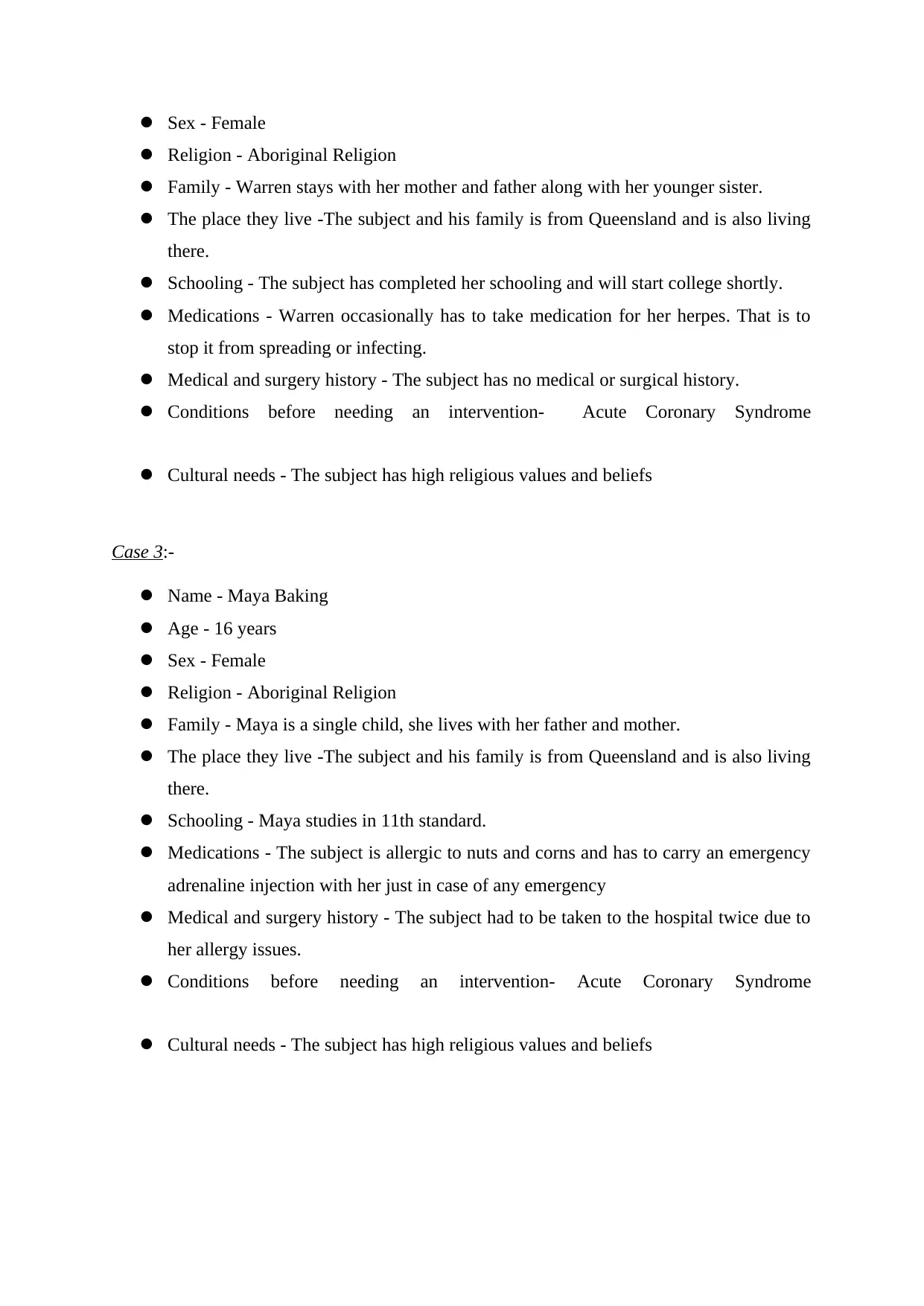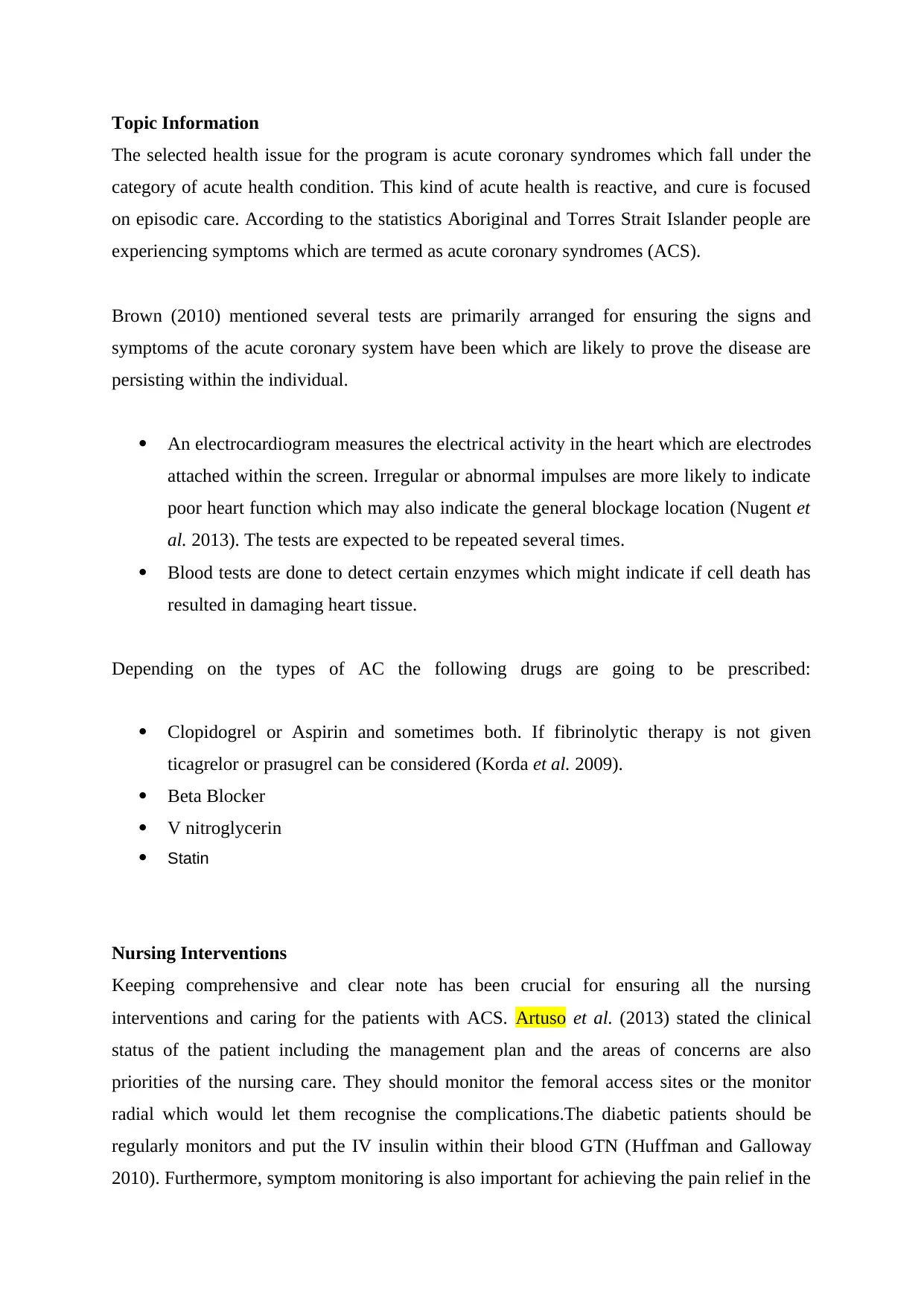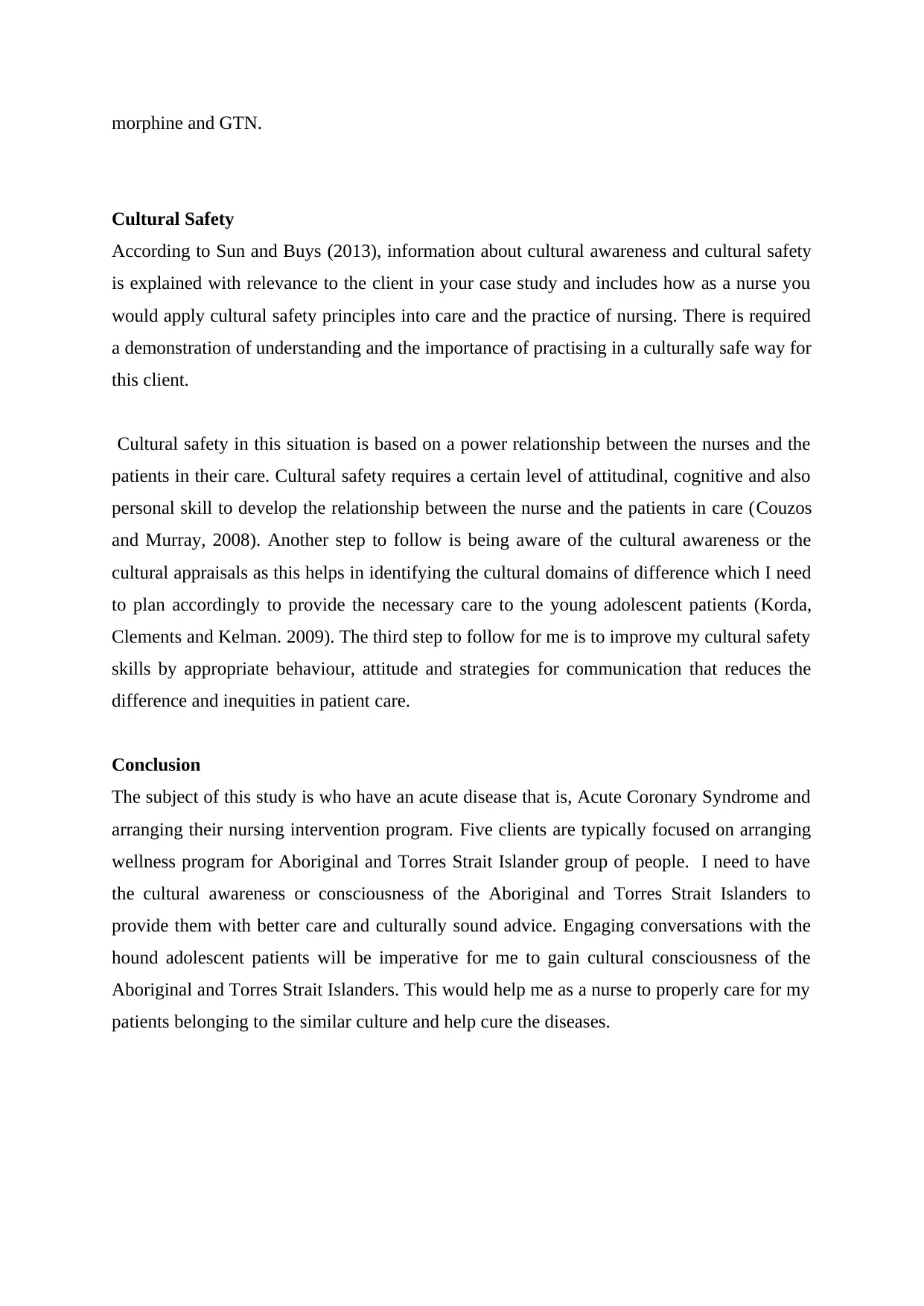Case Study on Acute Coronary Syndromes in Aboriginal Adolescents
VerifiedAdded on 2023/05/27
|6
|1478
|139
Case Study
AI Summary
This assignment presents a fictional case study focusing on Acute Coronary Syndromes (ACS) in Aboriginal and Torres Strait Islander (ATSI) adolescents aged 12-15 years. The study includes three cases, detailing their backgrounds, medical histories, and cultural needs. It provides information on ACS, diagnostic tests like electrocardiograms and blood tests, and potential drug prescriptions. The assignment emphasizes the importance of nursing interventions, including comprehensive note-taking, monitoring patient conditions, and managing diabetic patients with IV insulin. It also highlights cultural safety, underscoring the need for cultural awareness and sensitivity in providing care to ATSI patients, fostering trust, and improving health outcomes. The conclusion stresses the significance of cultural consciousness in delivering culturally sound advice and effective treatment to ATSI patients with ACS.

ASSIGNMENT
Paraphrase This Document
Need a fresh take? Get an instant paraphrase of this document with our AI Paraphraser

Introduction
The purpose of the present study is to build a fictional case study and produce in a digital
poster focusing upon the Aboriginal and Torres Strait Islander child health (0-15 years). Early
adolescence (12 to 15 years) group of the population have been targeted for ATSI health and
healthiness program. The specific health disease focused on people experiencing acute
coronary syndromes of symptoms.
Case study
The age group for the compiled case study has been considered to be adolescence. All of
these subjects are high school students.
Case 1:-
Name - Kirra Aibadu
Age - 15 years
Sex - Female
Religion - Aboriginal Religion
Family - Kirra lives with her father, mother and her three siblings. She has a younger
sister and a younger brother, along with an elder brother.
The place they live - The subject and his family is from Queensland and is also living
there.
Schooling - Kirra is in high school studying in 10th standard.
Medications - The subject does not take any medication.
Medical and surgery history - The subject has not medical or surgical history
Conditions before needing an intervention- Acute Coronary Syndrome
Cultural needs - The subject has moderate religious beliefs and values
Case 2:-
Name - Warren Leealowa
Age - 17 years
The purpose of the present study is to build a fictional case study and produce in a digital
poster focusing upon the Aboriginal and Torres Strait Islander child health (0-15 years). Early
adolescence (12 to 15 years) group of the population have been targeted for ATSI health and
healthiness program. The specific health disease focused on people experiencing acute
coronary syndromes of symptoms.
Case study
The age group for the compiled case study has been considered to be adolescence. All of
these subjects are high school students.
Case 1:-
Name - Kirra Aibadu
Age - 15 years
Sex - Female
Religion - Aboriginal Religion
Family - Kirra lives with her father, mother and her three siblings. She has a younger
sister and a younger brother, along with an elder brother.
The place they live - The subject and his family is from Queensland and is also living
there.
Schooling - Kirra is in high school studying in 10th standard.
Medications - The subject does not take any medication.
Medical and surgery history - The subject has not medical or surgical history
Conditions before needing an intervention- Acute Coronary Syndrome
Cultural needs - The subject has moderate religious beliefs and values
Case 2:-
Name - Warren Leealowa
Age - 17 years

Sex - Female
Religion - Aboriginal Religion
Family - Warren stays with her mother and father along with her younger sister.
The place they live -The subject and his family is from Queensland and is also living
there.
Schooling - The subject has completed her schooling and will start college shortly.
Medications - Warren occasionally has to take medication for her herpes. That is to
stop it from spreading or infecting.
Medical and surgery history - The subject has no medical or surgical history.
Conditions before needing an intervention- Acute Coronary Syndrome
Cultural needs - The subject has high religious values and beliefs
Case 3:-
Name - Maya Baking
Age - 16 years
Sex - Female
Religion - Aboriginal Religion
Family - Maya is a single child, she lives with her father and mother.
The place they live -The subject and his family is from Queensland and is also living
there.
Schooling - Maya studies in 11th standard.
Medications - The subject is allergic to nuts and corns and has to carry an emergency
adrenaline injection with her just in case of any emergency
Medical and surgery history - The subject had to be taken to the hospital twice due to
her allergy issues.
Conditions before needing an intervention- Acute Coronary Syndrome
Cultural needs - The subject has high religious values and beliefs
Religion - Aboriginal Religion
Family - Warren stays with her mother and father along with her younger sister.
The place they live -The subject and his family is from Queensland and is also living
there.
Schooling - The subject has completed her schooling and will start college shortly.
Medications - Warren occasionally has to take medication for her herpes. That is to
stop it from spreading or infecting.
Medical and surgery history - The subject has no medical or surgical history.
Conditions before needing an intervention- Acute Coronary Syndrome
Cultural needs - The subject has high religious values and beliefs
Case 3:-
Name - Maya Baking
Age - 16 years
Sex - Female
Religion - Aboriginal Religion
Family - Maya is a single child, she lives with her father and mother.
The place they live -The subject and his family is from Queensland and is also living
there.
Schooling - Maya studies in 11th standard.
Medications - The subject is allergic to nuts and corns and has to carry an emergency
adrenaline injection with her just in case of any emergency
Medical and surgery history - The subject had to be taken to the hospital twice due to
her allergy issues.
Conditions before needing an intervention- Acute Coronary Syndrome
Cultural needs - The subject has high religious values and beliefs
⊘ This is a preview!⊘
Do you want full access?
Subscribe today to unlock all pages.

Trusted by 1+ million students worldwide

Topic Information
The selected health issue for the program is acute coronary syndromes which fall under the
category of acute health condition. This kind of acute health is reactive, and cure is focused
on episodic care. According to the statistics Aboriginal and Torres Strait Islander people are
experiencing symptoms which are termed as acute coronary syndromes (ACS).
Brown (2010) mentioned several tests are primarily arranged for ensuring the signs and
symptoms of the acute coronary system have been which are likely to prove the disease are
persisting within the individual.
An electrocardiogram measures the electrical activity in the heart which are electrodes
attached within the screen. Irregular or abnormal impulses are more likely to indicate
poor heart function which may also indicate the general blockage location (Nugent et
al. 2013). The tests are expected to be repeated several times.
Blood tests are done to detect certain enzymes which might indicate if cell death has
resulted in damaging heart tissue.
Depending on the types of AC the following drugs are going to be prescribed:
Clopidogrel or Aspirin and sometimes both. If fibrinolytic therapy is not given
ticagrelor or prasugrel can be considered (Korda et al. 2009).
Beta Blocker
V nitroglycerin
Statin
Nursing Interventions
Keeping comprehensive and clear note has been crucial for ensuring all the nursing
interventions and caring for the patients with ACS. Artuso et al. (2013) stated the clinical
status of the patient including the management plan and the areas of concerns are also
priorities of the nursing care. They should monitor the femoral access sites or the monitor
radial which would let them recognise the complications.The diabetic patients should be
regularly monitors and put the IV insulin within their blood GTN (Huffman and Galloway
2010). Furthermore, symptom monitoring is also important for achieving the pain relief in the
The selected health issue for the program is acute coronary syndromes which fall under the
category of acute health condition. This kind of acute health is reactive, and cure is focused
on episodic care. According to the statistics Aboriginal and Torres Strait Islander people are
experiencing symptoms which are termed as acute coronary syndromes (ACS).
Brown (2010) mentioned several tests are primarily arranged for ensuring the signs and
symptoms of the acute coronary system have been which are likely to prove the disease are
persisting within the individual.
An electrocardiogram measures the electrical activity in the heart which are electrodes
attached within the screen. Irregular or abnormal impulses are more likely to indicate
poor heart function which may also indicate the general blockage location (Nugent et
al. 2013). The tests are expected to be repeated several times.
Blood tests are done to detect certain enzymes which might indicate if cell death has
resulted in damaging heart tissue.
Depending on the types of AC the following drugs are going to be prescribed:
Clopidogrel or Aspirin and sometimes both. If fibrinolytic therapy is not given
ticagrelor or prasugrel can be considered (Korda et al. 2009).
Beta Blocker
V nitroglycerin
Statin
Nursing Interventions
Keeping comprehensive and clear note has been crucial for ensuring all the nursing
interventions and caring for the patients with ACS. Artuso et al. (2013) stated the clinical
status of the patient including the management plan and the areas of concerns are also
priorities of the nursing care. They should monitor the femoral access sites or the monitor
radial which would let them recognise the complications.The diabetic patients should be
regularly monitors and put the IV insulin within their blood GTN (Huffman and Galloway
2010). Furthermore, symptom monitoring is also important for achieving the pain relief in the
Paraphrase This Document
Need a fresh take? Get an instant paraphrase of this document with our AI Paraphraser

morphine and GTN.
Cultural Safety
According to Sun and Buys (2013), information about cultural awareness and cultural safety
is explained with relevance to the client in your case study and includes how as a nurse you
would apply cultural safety principles into care and the practice of nursing. There is required
a demonstration of understanding and the importance of practising in a culturally safe way for
this client.
Cultural safety in this situation is based on a power relationship between the nurses and the
patients in their care. Cultural safety requires a certain level of attitudinal, cognitive and also
personal skill to develop the relationship between the nurse and the patients in care (Couzos
and Murray, 2008). Another step to follow is being aware of the cultural awareness or the
cultural appraisals as this helps in identifying the cultural domains of difference which I need
to plan accordingly to provide the necessary care to the young adolescent patients (Korda,
Clements and Kelman. 2009). The third step to follow for me is to improve my cultural safety
skills by appropriate behaviour, attitude and strategies for communication that reduces the
difference and inequities in patient care.
Conclusion
The subject of this study is who have an acute disease that is, Acute Coronary Syndrome and
arranging their nursing intervention program. Five clients are typically focused on arranging
wellness program for Aboriginal and Torres Strait Islander group of people. I need to have
the cultural awareness or consciousness of the Aboriginal and Torres Strait Islanders to
provide them with better care and culturally sound advice. Engaging conversations with the
hound adolescent patients will be imperative for me to gain cultural consciousness of the
Aboriginal and Torres Strait Islanders. This would help me as a nurse to properly care for my
patients belonging to the similar culture and help cure the diseases.
Cultural Safety
According to Sun and Buys (2013), information about cultural awareness and cultural safety
is explained with relevance to the client in your case study and includes how as a nurse you
would apply cultural safety principles into care and the practice of nursing. There is required
a demonstration of understanding and the importance of practising in a culturally safe way for
this client.
Cultural safety in this situation is based on a power relationship between the nurses and the
patients in their care. Cultural safety requires a certain level of attitudinal, cognitive and also
personal skill to develop the relationship between the nurse and the patients in care (Couzos
and Murray, 2008). Another step to follow is being aware of the cultural awareness or the
cultural appraisals as this helps in identifying the cultural domains of difference which I need
to plan accordingly to provide the necessary care to the young adolescent patients (Korda,
Clements and Kelman. 2009). The third step to follow for me is to improve my cultural safety
skills by appropriate behaviour, attitude and strategies for communication that reduces the
difference and inequities in patient care.
Conclusion
The subject of this study is who have an acute disease that is, Acute Coronary Syndrome and
arranging their nursing intervention program. Five clients are typically focused on arranging
wellness program for Aboriginal and Torres Strait Islander group of people. I need to have
the cultural awareness or consciousness of the Aboriginal and Torres Strait Islanders to
provide them with better care and culturally sound advice. Engaging conversations with the
hound adolescent patients will be imperative for me to gain cultural consciousness of the
Aboriginal and Torres Strait Islanders. This would help me as a nurse to properly care for my
patients belonging to the similar culture and help cure the diseases.

References
Artuso, S., Cargo, M., Brown, A. and Daniel, M., 2013. Factors influencing health care
utilisation among Aboriginal cardiac patients in central Australia: a qualitative study. BMC
Health Services Research, 13(1), p.83.
Brown, A., 2010. Acute coronary syndromes in indigenous Australians: opportunities for
improving outcomes across the continuum of care. Heart, Lung and Circulation, 19(5-6),
pp.325-336.
Couzos, S. and Murray, R., 2008. Aboriginal primary health care: an evidence-based
approach. Oxford University Press.
Huffman, M.D. and Galloway, J.M., 2010. Cardiovascular health in indigenous communities:
successful programs. Heart, Lung and Circulation, 19(5-6), pp.351-360.
Korda, R.J., Clements, M.S. and Kelman, C.W., 2009. Universal health care no guarantee of
equity: comparison of socioeconomic inequalities in the receipt of coronary procedures in
patients with acute myocardial infarction and angina. BMC Public Health, 9(1), p.460.
Nugent, A.W., Daubeney, P.E., Chondros, P., Carlin, J.B., Cheung, M., Wilkinson, L.C.,
Davis, A.M., Kahler, S.G., Chow, C.W., Wilkinson, J.L. and Weintraub, R.G., 2003. The
epidemiology of childhood cardiomyopathy in Australia. New England Journal of
Medicine, 348(17), pp.1639-1646.
Sun, J. and Buys, N., 2013. Participatory community singing program to enhance quality of
life and social and emotional well-being in Aboriginal and Torres Strait Islander Australians
with chronic diseases. International Journal on Disability and Human Development, 12(3),
pp.317-323.
Artuso, S., Cargo, M., Brown, A. and Daniel, M., 2013. Factors influencing health care
utilisation among Aboriginal cardiac patients in central Australia: a qualitative study. BMC
Health Services Research, 13(1), p.83.
Brown, A., 2010. Acute coronary syndromes in indigenous Australians: opportunities for
improving outcomes across the continuum of care. Heart, Lung and Circulation, 19(5-6),
pp.325-336.
Couzos, S. and Murray, R., 2008. Aboriginal primary health care: an evidence-based
approach. Oxford University Press.
Huffman, M.D. and Galloway, J.M., 2010. Cardiovascular health in indigenous communities:
successful programs. Heart, Lung and Circulation, 19(5-6), pp.351-360.
Korda, R.J., Clements, M.S. and Kelman, C.W., 2009. Universal health care no guarantee of
equity: comparison of socioeconomic inequalities in the receipt of coronary procedures in
patients with acute myocardial infarction and angina. BMC Public Health, 9(1), p.460.
Nugent, A.W., Daubeney, P.E., Chondros, P., Carlin, J.B., Cheung, M., Wilkinson, L.C.,
Davis, A.M., Kahler, S.G., Chow, C.W., Wilkinson, J.L. and Weintraub, R.G., 2003. The
epidemiology of childhood cardiomyopathy in Australia. New England Journal of
Medicine, 348(17), pp.1639-1646.
Sun, J. and Buys, N., 2013. Participatory community singing program to enhance quality of
life and social and emotional well-being in Aboriginal and Torres Strait Islander Australians
with chronic diseases. International Journal on Disability and Human Development, 12(3),
pp.317-323.
⊘ This is a preview!⊘
Do you want full access?
Subscribe today to unlock all pages.

Trusted by 1+ million students worldwide
1 out of 6
Related Documents
Your All-in-One AI-Powered Toolkit for Academic Success.
+13062052269
info@desklib.com
Available 24*7 on WhatsApp / Email
![[object Object]](/_next/static/media/star-bottom.7253800d.svg)
Unlock your academic potential
Copyright © 2020–2025 A2Z Services. All Rights Reserved. Developed and managed by ZUCOL.





